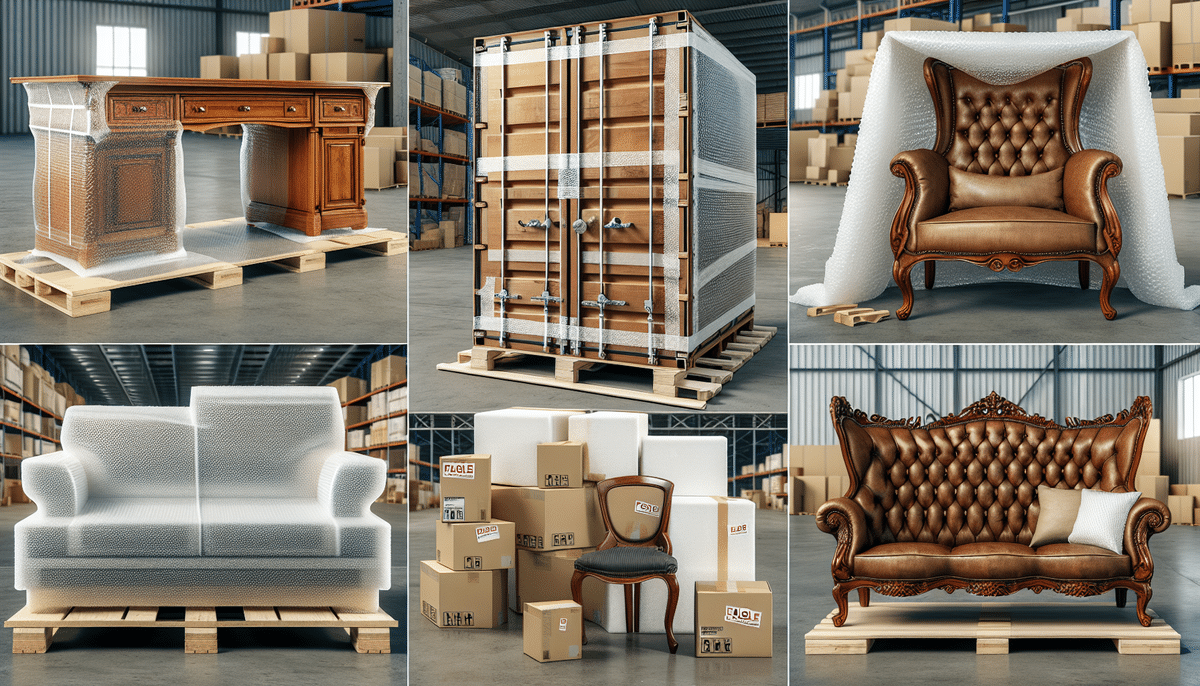Gaining Expertise in Shipping Furniture: Tips and Strategies
Shipping furniture is a complex process that requires significant expertise. It's not just about placing items in boxes and sending them off. Multiple factors contribute to ensuring your furniture arrives at its destination in the same condition it left your home. In this article, we will explore comprehensive tips and strategies to help you become an expert in furniture shipping.
Why Shipping Furniture Requires Expertise
Unlike other items, furniture is often bulky and heavy, necessitating special handling. Additionally, furniture typically holds more value, increasing the stakes if something goes wrong during shipping. Different forms of furniture, from delicate antiques to sturdy couches, each require specific conditions for successful transport. Shipping companies often charge extra for oversized or heavy items, making proper packaging crucial to minimize costs and avoid additional fees.
Another complexity in shipping furniture is the potential need for disassembly and reassembly. Items such as beds or dining tables may need to be taken apart to fit through doorways or into elevators. This process demands knowledge of how to safely disassemble and reassemble furniture without causing damage. Without proper expertise, delicate or intricate parts could be easily damaged or lost during shipping.
Understanding the Different Types of Furniture and Their Shipping Requirements
Before shipping any piece of furniture, it's essential to understand the specific requirements of the item. For example, antique furniture requires more careful and delicate handling, while other items might need special packaging or labeling. Different materials used in furniture construction—such as wood, metal, and upholstery—each have unique shipping considerations. Additionally, weight and size limitations vary depending on the shipping company and method chosen.
According to a 2023 report by the International Furniture Shipping Association, wooden furniture accounts for approximately 40% of shipped items, necessitating robust packaging solutions to prevent damage during transit.
Choosing the Right Packaging Materials for Your Furniture
Proper packaging is one of the most critical aspects of shipping furniture. Selecting materials that are the right size and shape for each piece, and strong enough to protect it during transport, is essential. Common packaging materials include bubble wrap, packing paper, foam padding, and sturdy cardboard boxes. Special considerations may be required for specific furniture pieces.
- Bubble Wrap: Ideal for protecting delicate surfaces from scratches and minor impacts.
- Packing Paper: Useful for cushioning and separating different parts of the furniture.
- Foam Padding: Provides additional protection against shocks and vibrations.
- Cardboard Boxes: Essential for containing smaller components and preventing movement.
When selecting packaging materials, consider the environmental impact. Opt for recyclable or biodegradable options like cardboard boxes or paper padding to reduce waste and demonstrate a commitment to sustainability.
Cost is another factor. While protection is paramount, overspending on unnecessary packaging can inflate shipping costs. Utilizing household items such as blankets or towels to wrap furniture can be a cost-effective alternative to purchasing specialized foam padding.
Packing Your Furniture Like a Pro: Step-by-Step Instructions
- **Disassemble Furniture:** Start by disassembling any furniture that can be taken apart, such as tables and beds.
- **Wrap Each Piece:** Use protective packaging to cover all corners and edges of each component.
- **Secure Non-Disassembled Items:** If certain pieces cannot be disassembled, ensure they are well-padded and secured within the box.
- **Seal and Label:** Close and seal the box securely, adding necessary labels or instructions for the shipping company.
- **Weight Distribution:** Place heavier items at the bottom of the box and lighter items on top to prevent damage during transit.
For international shipments, research any relevant customs regulations and requirements to ensure a smooth delivery process. Additionally, documenting your furniture with photographs before packing can serve as evidence in case of damage during shipping. Consider purchasing insurance to protect against unforeseen events.
How to Protect Your Furniture from Damage During Shipping
Even with the best packaging, shipping furniture carries inherent risks. To minimize potential damage:
- Label as Fragile: Clearly mark packages as fragile and indicate that they should be handled with care.
- Choose Reputable Shipping Companies: Select companies with strong reputations for handling furniture and verify their insurance coverage.
- Additional Insurance: Consider purchasing extra insurance to ensure full protection for valuable items.
- Disassemble When Possible: Reduces handling complexity and the risk of damage.
- Use Protective Coverings: Wrap furniture in bubble wrap or furniture blankets to provide an extra layer of protection.
According to the 2023 Furniture Shipping Guidelines, properly disassembled and wrapped furniture experiences a 25% reduction in damage incidents during transit.
Tips for Loading and Unloading Furniture Safely and Efficiently
If you're handling the shipping process yourself, proper loading and unloading techniques are crucial:
- Assess Weight and Size: Determine the best way to load each piece based on its dimensions and weight.
- Use Proper Lifting Techniques: Prevent injuries by using correct lifting methods and appropriate equipment.
- Clear Unloading Space: Ensure there's ample space to unload items without causing damage.
- Labeling: Mark each piece with its corresponding room or location in your new home for easy placement.
- Secure Additional Items: If transporting other belongings alongside furniture, secure them to prevent shifting.
Implementing these practices can lead to a smoother, stress-free moving experience. Leveraging proper moving equipment, such as dollies and straps, can further enhance safety and efficiency.
How to Choose the Best Shipping Company for Your Needs
Selecting the right shipping company is vital for the successful transport of your furniture. Consider the following factors:
- Reputation: Research customer reviews and testimonials to gauge the company's reliability.
- Experience: Choose companies with proven experience in furniture shipping.
- Pricing: Compare rates from multiple companies to find competitive pricing.
- Insurance Coverage: Ensure the company offers adequate insurance to protect against damage or loss.
- Customer Service: Opt for companies with responsive and helpful customer support.
Reading reviews on platforms like ShipScience Customer Reviews can provide insights into the experiences of other customers. Additionally, asking for recommendations from friends or family can help identify trustworthy shipping providers.
Understanding Shipping Regulations and Restrictions for Furniture
Before shipping furniture, it's essential to familiarize yourself with relevant shipping regulations and restrictions, which may vary based on the destination:
- Weight and Size Limitations: Different shipping companies have varying limits on the dimensions and weight of shipments.
- Prohibited Materials: Certain materials or items may be restricted or require special permits.
- International Regulations: Countries may have specific requirements for importing furniture, including taxes and duties.
Special handling or packaging might be necessary for items like glass or mirrors to prevent damage. Evaluating different shipping options and carriers can help identify the most cost-effective and compliant solutions for your needs.
For detailed regulations, refer to the ShipScience Shipping Regulations Guide.
How to Handle Unexpected Challenges During Furniture Shipping
Despite meticulous planning, unexpected challenges can arise during furniture shipping, such as delays, damage, or lost items. To effectively manage these situations:
- Contingency Planning: Develop backup plans for various potential issues.
- Stay Calm: Maintain composure to address problems efficiently.
- Clear Communication: Engage in open and transparent communication with the shipping company and other involved parties.
Establishing a clear protocol for resolving issues can expedite the resolution process and minimize stress. Ensuring all parties are informed and coordinated is key to overcoming unexpected obstacles.
Cost-Saving Strategies for Shipping Furniture
Shipping furniture can be expensive, especially for large or numerous items. Implementing cost-saving strategies can help reduce expenses:
- Compare Shipping Rates: Shop around and compare prices from different shipping companies to find the best deal.
- Use Consolidation Services: Combine multiple shipments into one to take advantage of bulk discounts.
- Disassemble Larger Items: Reducing the size and weight of items by disassembling them can lower shipping costs.
- Pack Efficiently: Optimize packaging to minimize the volume and weight of the shipment.
Utilizing these strategies can lead to significant savings. According to ShipScience's 2023 Cost Analysis Report, effective packing and consolidation can reduce shipping costs by up to 30%.
Best Practices for Tracking and Monitoring Your Furniture Shipment
Once your furniture is shipped, tracking its progress is essential to ensure timely and safe delivery:
- Choose a Shipping Company with Tracking Services: Ensure your chosen provider offers real-time tracking capabilities.
- Regular Monitoring: Frequently check the status of your shipment to stay informed about its location and estimated arrival.
- Keep Documentation: Maintain records of all communications, receipts, and shipment documentation for reference.
Modern tracking technologies allow for precise monitoring. Utilizing these tools can provide peace of mind and facilitate quick responses to any issues that may arise during transit.
For more information on tracking services, visit the ShipScience Tracking Services page.
How to Deal with Customer Complaints Regarding Damaged or Lost Shipments
Customer complaints can occur due to damages or lost items during shipping. Handling these complaints effectively is crucial for maintaining trust and satisfaction:
- Establish Clear Procedures: Develop a standardized process for investigating claims and resolving disputes.
- Offer Compensation: Provide appropriate compensation or replacements for damaged or lost items.
- Communicate Professionally: Maintain clear and respectful communication with customers throughout the resolution process.
Having a transparent and responsive approach to complaints can enhance customer relationships and mitigate negative impacts. Refer to ShipScience's Customer Service Guidelines for best practices in handling complaints.
Future Trends in Furniture Shipping: What You Need to Know
The furniture shipping industry is continually evolving with advancements in technology, new practices, and updated regulations. Staying informed about these trends is essential for adapting to changes that may affect your shipping strategies:
- Automation and Robotics: Increased use of automated systems and robotics in warehouses and during transport to improve efficiency.
- Sustainable Shipping Practices: Growing emphasis on eco-friendly packaging and transportation methods to reduce environmental impact.
- Enhanced Tracking Technologies: Implementation of more sophisticated tracking systems for better real-time monitoring.
- Customized Shipping Solutions: Development of tailored shipping options to meet specific customer needs and preferences.
Keeping abreast of these trends can help you leverage new technologies and practices to enhance your furniture shipping processes. For insights on future trends, consult the ShipScience Future Trends Report.
The Importance of Good Communication in Successful Furniture Shipping
Effective communication is a cornerstone of successful furniture shipping. Whether interacting with the shipping company, customers, or other stakeholders, clear and consistent communication helps minimize errors and misunderstandings:
- Regular Updates: Keep all parties informed about the shipment's status and any changes that occur.
- Transparent Policies: Clearly communicate shipping policies, procedures, and expectations to avoid confusion.
- Responsive Support: Provide prompt and helpful responses to inquiries and issues.
Good communication ensures that everyone involved is aware of their roles and responsibilities, leading to a smoother shipping process. Implementing robust communication channels can significantly enhance the overall experience.
Conclusion
Shipping furniture is a multifaceted process that demands expertise and careful planning. By understanding the different types of furniture, selecting appropriate packaging materials, and adhering to best practices for loading, unloading, and tracking shipments, you can master the art of furniture shipping. Incorporating the tips and strategies outlined in this article will help you protect your valuable furniture and ensure its safe arrival at its destination.






















